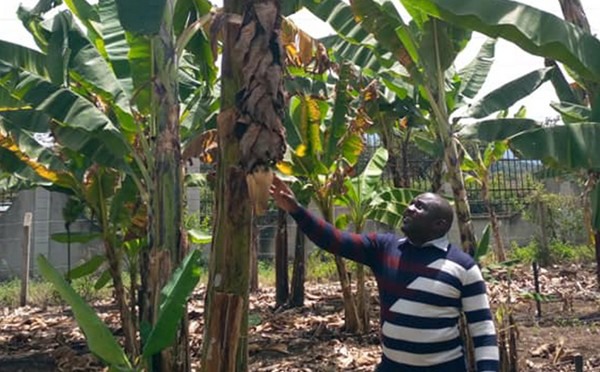To address the threat of Fusarium Wilt (FW) to banana production in Tanzania, IITA–CGIAR and collaborators—Nelson Mandela African Institution of Science and Technology (NM-AIST) and Tanzania Agricultural Research Institute (TARI), have announced the handover of four FW-resistant Mchare cooking bananas for multi-site evaluation by TARI and the Tanzania Official Seed Certification Institute (TOSCI) in the country.  For eight years, the IITA breeding and internal pathology department collaborated with partners from Wageningen and Stellenbosch Universities to generate Mchare hybrids resistant to various races of the Fusarium wilt fungus. FW (known locally as Panama disease) Race 1 has become a nightmare to Tanzanian farmers as the fungus can exist in the soil for about 20 years. Another strain, the Tropical Race 4 (TR4), is present in neighboring Mozambique.
For eight years, the IITA breeding and internal pathology department collaborated with partners from Wageningen and Stellenbosch Universities to generate Mchare hybrids resistant to various races of the Fusarium wilt fungus. FW (known locally as Panama disease) Race 1 has become a nightmare to Tanzanian farmers as the fungus can exist in the soil for about 20 years. Another strain, the Tropical Race 4 (TR4), is present in neighboring Mozambique.
“The resistant Mchare hybrids will ensure that Tanzanian farmers will be able to deal with the FW strains present in Tanzania today and those they are likely to encounter in the future,” said Allan Brown, the banana breeder from IITA.
In addition to being resistant to FW, Brown also noted that the texture, color, aroma, and flavor of the new hybrids suggest that they are not significantly different from conventional Mchare landraces, according to consumer preference scores. However, their yields have increased up to 65%.

Mchare bananas are a cooking banana favored in Tanzania—the global center of Mchare bananas—and in segments of Kenya and other East African countries. According to Government officials, the Kilimanjaro region of Tanzania produces an average of 700,000 to one million tons of bananas annually, with a single bunch of Mchare bringing up to USD 20 in the local markets.
“The development of new banana hybrids can take up to two decades or more, so the development of these promising hybrids that meet and exceed our product profile in just over seven years is a truly remarkable achievement and a testament to the hard work of the team in Tanzania and the great relationship between IITA and the national programs and international partners,” expressed Rony Swennen, the lead banana breeder from IITA.
The efforts undertaken by the IITA team in collaboration with its partners will enhance the significance of bananas not only as a vital food and cash crop but also as a catalyst for bolstering the economy of smallholder farmers. TARI and TOSCI have already released four matooke hybrids developed by NARO (National Agricultural Research Organisation, Uganda) and IITA, called NARITA, in 2021 in Tanzania. These matooke hybrids, locally named TARIBAN, are currently multiplied on a large scale by two TARI and two private tissue culture labs.
For more information:
www.iita.org
